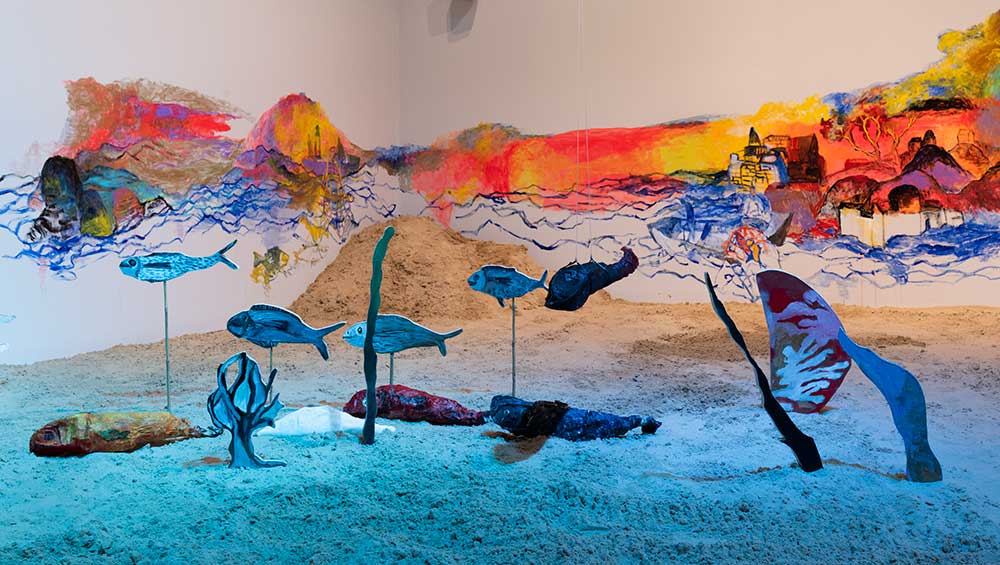
Anna Boghiguian The Sunken Boat: A glimpse into past histories, 2025. Installation view, Courtesy Turner Contemporary. Photo: Thierry Bal.
Turner Contemporary, Margate
14 June 2025 – 26 October 2025
by JOE LLOYD
The best place to hear the sea in Margate is the Turner Contemporary. For her installation The Sunken Boat (2025), the Egyptian Canadian artist Anna Boghiguian (b1946, Cairo) has brought the sounds of the seas into the gallery. Gentle rolls give way to crashing waves, recorded in Margate and Alexandria. This soundtrack accompanies an uneven carpet of sand, sprinkled with painted cut-outs. These include a school of fish, two scuba divers and a shipwreck. There are also found objects such as branches and shells, and worm-like metallic pipes. The lower torsos of swimmers hang from the ceiling. A coastal city is painted on the wall in fiery summer colours. But waves are encroaching. Soon the city might join us underwater.
The messages of this installation seem crystal clear. The oceans are witness to human and animal life, technology and history; they house complex seen and unseen systems. Also, climate change is coming. One day the sea will prevail. This may be too obvious for some, too generalised for others. But Boghiguian has a gift for the aesthetic and the sensorial that makes the installation a pleasure to behold. Her painted cut-outs sit somewhere between Marlene Dumas paintings and Quentin Blake illustrations, observation balanced with whimsy. A repurposed Untitled (2023) work shows the papier-mache head of a crocodile snap out of the wall; nearby, but impossibly far from this maw, a reptilian hand grabs a fish. Boghiguian facilitates a landscape in which you want to linger – and stew with your own aquatic thoughts.
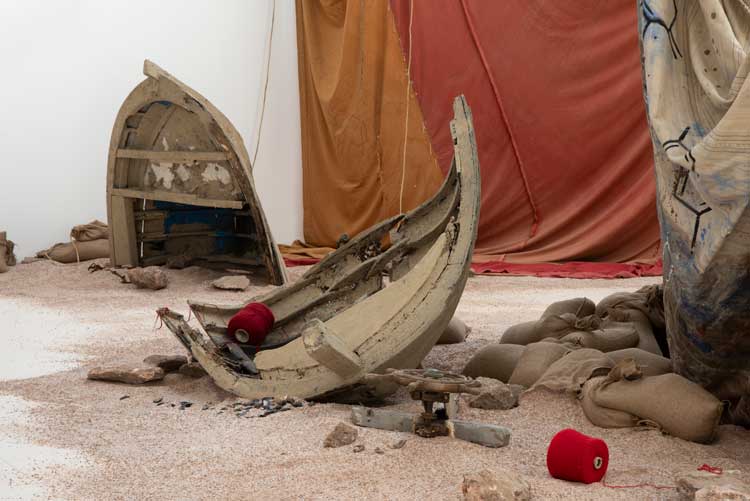
Anna Boghiguian The Sunken Boat: A glimpse into past histories, 2025. Installation view, Courtesy Turner Contemporary. Photo: Thierry Bal.
Boghiguian has sharpened this mode for decades. But in the past 15 years she has reached a new level of prominence as a perennial biennale fixture. Star curator Carolyn Christov-Bakargiev placed her in Documenta 13 (2012) and the Istanbul Biennial (2015). She was one of the artists in the Golden Lion-winning Armenian Pavilion at the 2015 Venice Biennale. Exhibitions in major institutions have followed, including the Tate St Ives in 2019. Boghiguian is a dab hand when it comes to working at scale, assembling beguiling installations that immediately arrest the senses and knit together various social and political strands.
The Salt Traders (2015), first created for Istanbul, is the paradigmatic example of this practice. It images a Roman merchant boat re-emerging after the melting of the ice caps. Fragments of this vessel are strewn around the room. Sails hang from the ceiling, tackle and sandbags pile up on the ground. As with The Sunken Boat, Boghiguian has covered the floor with a powdery substance, this time salt crystals, the ancient vessel’s lost cargo. A sculptural fish lies helplessly on the ground. But this is not simply the stage set of an archaeological discovery – Boghiguian interrupts her scene with signs of the artist’s presence. One of the sails is painted with a distorted world map roughly identifying sites of salt mining.
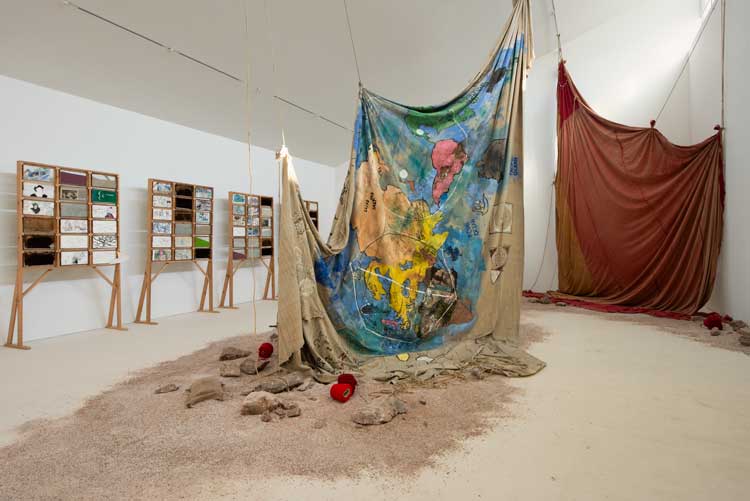
Anna Boghiguian The Sunken Boat: A glimpse into past histories, 2025. Installation view, Courtesy Turner Contemporary. Photo: Thierry Bal.
On the wall around are eight wooden frames, each divided into 18 panels: Boghiguian’s museum of salt, colonial history and injustice. These contain paintings, drawings, collage, newspaper clippings, texts and vitrines containing different brands of salt. Several contain fragments of honeycomb, which Boghiguian connects to the hexagonal chemical structure of sodium chloride. Many reference the history and culture surrounding salt, such as Alexander the Great’s journey to the Egyptian salt lakes and Mahatma Gandhi’s 1930 march against colonial India’s oppressive salt laws.
Turkey is one focus: there is a cut-out of Barack Obama embracing Recep Tayyip Erdoğan and a capsule biography of Sultan Mehmed II of the Ottoman Empire. This might connect back to Byzantium’s status as a centre for the salt trade. It was also a slavery hub, and on other screens Boghiguian attempts to link this to the earliest European abolition of the transatlantic slave trade in 1803. A list of Americans killed by police during a few months in 2015 reveals exactly what you would expect about the background and gender of victims. Contemporary inequality and injustices are linked to the legacy of slavery. We have moved far from the salt trade and the Roman vessel on one hand. And yet we remain very close. At her best, Boghiguian makes these conflations of history and geography seem natural. Her works resemble a vast mind map, lucid even when it threatens to overwhelm with the sheer number of links.
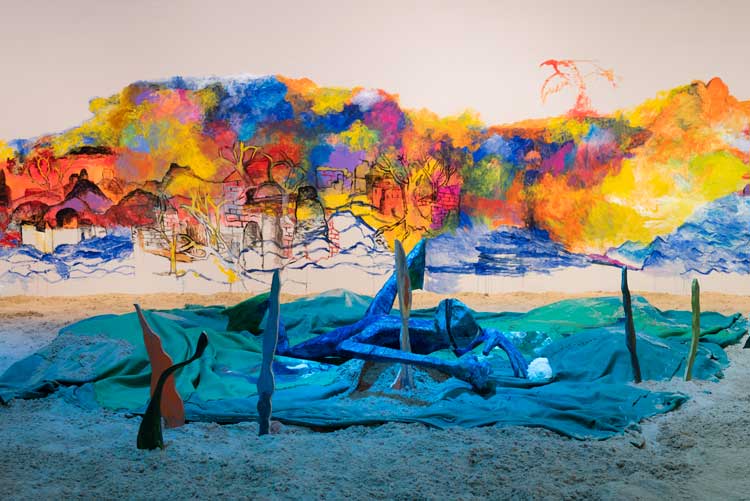
Anna Boghiguian The Sunken Boat: A glimpse into past histories, 2025. Installation view, Courtesy Turner Contemporary. Photo: Thierry Bal.
Connections also animate her smaller-scale artworks. These two room-spanning installations are augmented by Sea and Earth (2024), a pair of bronze sculptures of bizarre spidery beings. They have emaciated upper bodies like Giacometti figures and faces based on seashells. The craggy surfaces of these torsos seem like underwater geology. Their lower bodies, however, are cast from tree branches, which retain the grain of their models. Boghiguian stresses the interconnectivity of the natural world, where trees and the sea are essential for the continuance of life on Earth. Beyond any message, though, they are effective works of sculpture.
A third large-scale installation at Margate, The Square, The Line and The Ruler. Ambiguous Philosophers / Ambiguous Politicians (2019), was first displayed at Beaux-Arts de Paris. It features a giant chess board, above which Boghiguian has hung puppet-like paintings of famous philosophers and politicians. These are characteristically lively. They are often witty, without becoming caricature. Pythagoras appears as a classical bust atop geometric storms, a topless Vladimir Putin bestrides a horse and Winston Churchill puffs on a cigar.
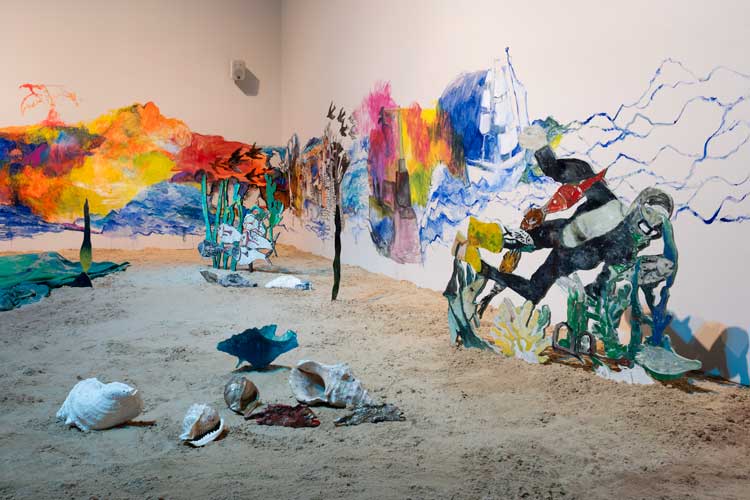
Anna Boghiguian The Sunken Boat: A glimpse into past histories, 2025. Installation view, Courtesy Turner Contemporary. Photo: Thierry Bal.
Chess is a descendant of the medieval Indian game chaturanga, whose pieces resemble army divisions, and simulates a battle between two armies. Boghiguian here envisages a war between thinkers and rulers, between thought and action (it is easy to choose which side to back, given the numerous colonial and authoritarian rulers that dominate the political side). As you move around the crowded room, new combinations of figures emerge. Compared to the complexities and questions opened by the other installations, this feels a little too straightforward. Writers and artists from Thomas Middleton to Samuel Beckett have mined chess for symbolism. There is a not much left to extract. But what a sight to behold.